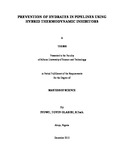| dc.description.abstract | Chemical method is the most efficient and flexible method of hydrate control in offshore operations. In recent times, polymers and surfactants have been used to influence the kinetics of hydrate growth and coagulation. However, the traditional polar solvents are still relevant because
of their ability to melt hydrates. Due to the large volume of polar thermodynamic inhibitors usually required in the field, this work examines the effect of hybrid hydrate inhibitors (HHI) comprising both polar and ionic thermodynamic hydrate inhibitors.
In this study, a Microsoft Excel-based program was developed for evaluating the effectiveness of various polar thermodynamic hydrate inhibitors and hybrid thermodynamic hydrate inhibitors in preventing hydrate deposition. Katz plot was used in obtaining the hydrate
formation temperature, when the fluid composition and operating pressure were supplied. Østergaard, Hammerschdmidt and Nielsen Bucklin equation gave the temperature depression and quantity of inhibitor required to prevent hydrate depression in the pipes. Two pipes, Branch 4 &
Branch 9, in a fictitious offshore field were used as case study. It was discovered that the quantity of Methanol (MeOH) required in Branch 4 and Branch 9 decreased by 44.5% when Methanol-hybrid Thermodynamic Hydrate Inhibitor (consisting of methanol and salt) was used. The required Mono Ethylene Glycol (MEG) and Di Ethylene Glycol (DEG) also decreased by 33.6% and 35.9% respectively when combined with salt. It was concluded that the most effective hybrid inhibitor is Methanol-Sodium Chloride hybrid because it saved 44.5% of Methanol when used in Branch 4 and 45% Methanol when used in Branch 9.
This work enables a flow assurance engineer to calculate the quantity of inhibitor required on the field to prevent hydrate formation on a salt free basis and when the produced water contains salt. | en_US |

